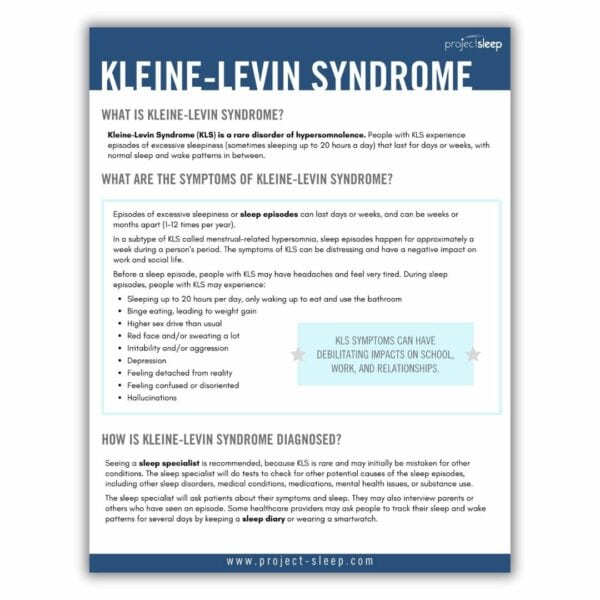Kleine-Levin Syndrome (KLS) is a rare disorder of hypersomnolence. People with KLS experience episodes of excessive sleepiness (sometimes sleeping up to 20 hours a day) that last for days or weeks, with normal sleep and wake patterns in between.
Kleine-Levin Syndrome (KLS)
What are the symptoms of Kleine-Levin Syndrome?
Before a sleep episode, people with KLS may have headaches and feel very tired. During sleep episodes, people with KLS may experience:
- Sleeping up to 20 hours per day, only waking up to eat and use the bathroom
- Binge eating, leading to weight gain
- Higher sex drive than usual
- Red face and/or sweating a lot
- Irritability and/or aggression
- Depression
- Feeling detached from reality
- Feeling confused or disoriented
- Hallucinations
Sleep episodes can last days or weeks and can be weeks or months apart (1-12 times per year). In a subtype of KLS called menstrual-related hypersomnia, sleep episodes happen for the week approximately during a person’s menstrual period. The symptoms of KLS can be distressing and have a negative impact on work and social life.
How is Kleine-Levin Syndrome diagnosed?
Seeing a sleep specialist is recommended. KLS is rare and may initially be mistaken for other conditions.
A sleep specialist will do tests to check for other potential causes of the sleep episodes, including other sleep disorders, medical conditions, medications, mental health issues, or substance use.
The sleep specialist will ask patients about their symptoms and sleep. They may also interview parents or others who have seen an episode. Some healthcare providers may ask people to track their sleep and wake patterns for several days by keeping a sleep diary or wearing a smartwatch.
Multiple tests can be done in a sleep center/lab to check for other sleep disorders. In these tests, stick-on sensors measure breathing, heart rate, brain activity, and body movements while asleep. These tests could include:
- Overnight sleep study (polysomnography): measures a full night’s sleep
- Multiple sleep latency test: measures how a person sleeps during the day after an overnight sleep study; person is asked to nap for around 20 minutes every 2 hours
- Maintenance of wakefulness test: measures how long a person can stay awake in a dark, quiet, comfortable room, done during the day after a full night’s sleep
How is Kleine-Levin Syndrome treated?
Treatment is focused on managing a person’s specific symptoms. There is no cure for KLS, but symptoms often improve over several years.
These medications are not specifically indicated for KLS, but may help people with KLS to stay awake during episodes and go to work or school. However, they may also increase irritability.
For menstrual-related hypersomnia, hormonal birth control medication may prevent sleep episodes.
Social support from people with KLS or other hypersomnias can empower people with KLS and their families to live well.
Additional Resources
Please download our free, printable KLS Fact Sheet. This handy resource can be shared with friends, family, and medical providers.








